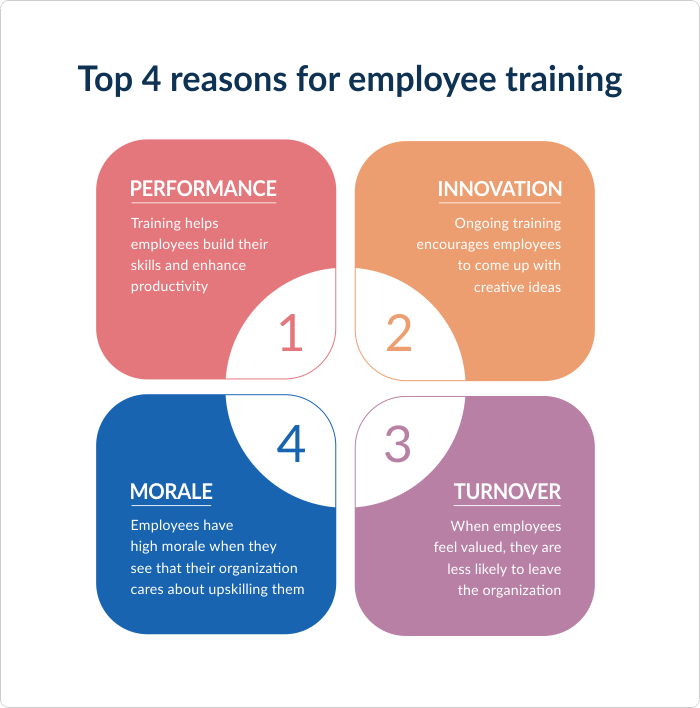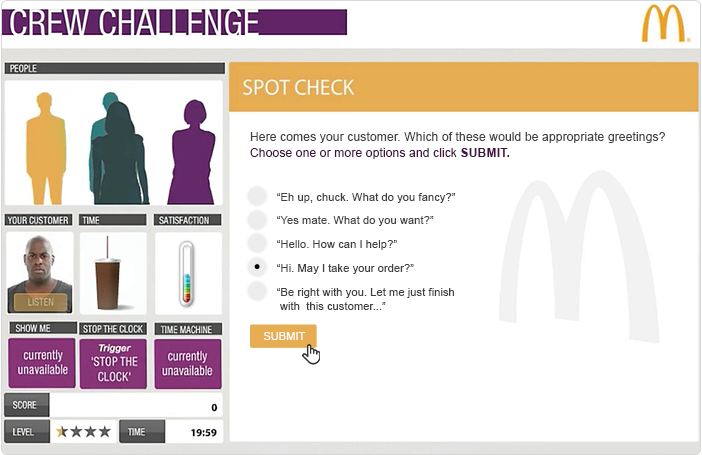14 Proven Training Methods for Boosting Staff Performance

According to a Training Industry report, average training expenditures for large companies amounted to $16.1 million. The number for midsize companies was $1.5 million. You might be wondering why organizations spend such large amounts on training. Well, here are a few reasons why organizations must take employee training seriously and try different training methods:

Here are some employee training methods you can consider:
- Instructor-led training (ILT)
- eLearning
- Blended learning
- Immersive learning
- Social learning
- Experiential learning
- Hands-on Training
- Case studies
- Coaching
- Video training
- Job shadowing
- Role-playing
- Gamification
- Mobile learning
Training Method 1: Instructor-Led Training (ILT)
Instructor-led training refers to training methods that occur in a classroom (in person or virtual). It can have more than one instructor who teaches through lectures, discussions, and demonstrations. ILTs are most beneficial for complex content because learners have the option to ask questions directly and clarify their doubts.
Common ILT formats
| Face-to-face training | Face-to-face training is the traditional classroom training method that has been around for quite some time, involving lectures, conferences, seminars, etc. |
| Virtual classroom | In a virtual classroom environment, participants can communicate and interact in an online setting, mostly through video conferencing. They can collaborate with the instructor, as well as the other learners. |
| Webinar | In webinars, learners participate in an online lecture. They can post questions and answer polls. In most cases, learners interact with the instructor and not with fellow learners. |
With instructor-led training, you don’t need to present content in lecture format only. There are several options to do this. For example, you could try the storytelling method to make it interesting or create a panel of experts and allow the learners to engage with them.
Brainstorming is also a common training technique in instructor-led training. You can ask the learners to write their thoughts on a flip chart or sticky notes. Participants can work individually or in groups. You can even consider throwing them open-ended questions to see what ideas they come up with.
Pros and cons of ILT
Pros
- ILT is a training strategy that has a personal touch. The training instructor and the learners can interact directly face to face. They can gauge each other’s body language and tone of voice, allowing them to adapt accordingly.
- Everyone receives the same information at the same time.
- The learners can clarify their doubts with the trainer in real time.
- Group interactions help learners gain insights from each other.
Cons
- Instructor-led training methods can be quite expensive since they can require investment in travel and accommodations for the learners and the instructors. Other expenses include renting a training venue, equipment, and renting a training venue and equipment.
- Classroom training has limited space for the participants.
- It’s a logistical nightmare to get everyone in one place at the same time.
- The participants miss out on their daily tasks while attending the training at a fixed date and time, which affects productivity.
- The limiting factor of the speed of the class is the weakest and the slowest participants.
Training Method 2: eLearning
eLearning is the delivery of learning through a computer or any digital device. It lends itself to a wide range of industries, such as retail, healthcare, and automotive. Based on 2024 statistics, 90% of organizations use some form of eLearning in their training. This high number is not a surprise, considering the various advantages it offers.
Common eLearning formats
Online courses
An online course is a self-paced, asynchronous course that allows your employees to complete training online, meaning they don’t need to be physically available at a training venue. Learners can take a course during their free time, from anywhere they choose, like their living room or the subway. As long as they have a mobile device with an internet connection, they can access courses on demand.
Previously, course creation for online training was a complex task, even for technical specialists, but now it’s possible to build eLearning courses with no programming skills. You only need an authoring tool like iSpring Suite. It has a complete package of components for creating multi-platform interactive eLearning courses right in PowerPoint.
See what a course created in iSpring Suite looks like:
To share a course with learners, you can upload it to a cloud service and email a link to your employees or add the course to your website. However, if you want to manage the online training process easily and keep track of how learners view the content and the results they get, you’ll need to upload it to a learning management system (LMS) like iSpring LMS. To have a comprehensive look at the learning platform, read our blog post on LMSs.
Online games and quizzes
According to research, the global game-based learning market is growing fast—it was worth $19.32 billion in 2023 and is expected to reach $75.26 billion by 2032, with an annual growth rate of 16.31%. It’s all about taking a boring task or process and turning it into an online game to boost user motivation.
A great example of game-based learning is McDonald’s UK Till Training Game. It delivers a memorable learning experience to support the launch of a new till system in 1,300 restaurants. The game encourages learners to practice their customer-handling skills. Employees handle orders while being timed. They have to display their knowledge of the till system while keeping the customers happy. Gaming elements like bonuses, lifelines, and panels are added to boost engagement.

Online quizzes are also a kind of gamified learning. eLearning authoring tools usually provide options to create such quizzes. For example, with iSpring Suite, you can create drag-and-drop activities. To see how it looks, experience this eLearning demo about the basic rules of merchandising:
iSpring Suite also makes it easy to build interactive assessments with rich media, video, drag-and-drops, branching, and flexible scoring and testing rules. Below is a fragment of an online quiz created with iSpring Suite from Learning Nurse, an informal learning platform for nursing students.

Video tutorials
Video tutorials are the best way to teach a process or walk through its various steps. They’re usually brief and perfect for such tasks as employee onboarding or cross-training. They leverage several effective training methods, like direct instruction, quizzing, and follow-along guidance.
If you need to create professional-looking video courses, how-to videos, and software tutorials, you can easily do this with iSpring Suite. It has a built-in professional video studio that allows you to record screencasts and webcam videos of training sessions.
This is what a video lesson made with iSpring looks like:
Conversation simulations
A dialogue simulation training is an interactive exercise that simulates an actual conversation with an individual. It helps your employees master communication skills with no risk of rushing a deal or damaging their relationship with a client.
This is an example of a conversation simulation created in iSpring Suite:
Pros and cons of eLearning
Pros
- Learners can access learning anytime, anywhere.
- There’s no investment needed for travel, accommodation, venue, printouts, etc.
- Learners can choose their own pace and learning path if you let them.
- It helps present learning content in an engaging manner.
Cons
- If the target audience is not tech-savvy, they may not find this computer-based training method suitable.
- It lacks a human element.
- The learners don’t have face-to-face access to an instructor in real time if they have questions.
- You need to invest in authoring tools and content/learning management systems.
Training Method 3: Blended Learning
Blended learning refers to a teaching method that integrates technology with live, location-based classroom activities and allows learners to get the best of both online and traditional training methods. There may be different ways of “blending” here, so every company needs to find a model that works for its employees.
Models of blended learning
| Flipped model | This is the reverse of the traditional classroom training methods where the learners are taught in the class and then given homework. In this model, the learners are provided with the content before the class. They go through it independently online. During the classroom session, they discuss the content and perform various activities to ensure that they have understood the concepts. |
| Face-to-face driver model | This is one of the most utilized training techniques in the workplace. Here, a chunk of a classroom session is replaced with online activities. The classroom instruction, along with pre- and post-class activities, is carried out online by the instructors. This training approach is best suited for participants who come from diverse professional backgrounds. |
| Flex model | In this type of training, the learners complete most of their courses online with a small portion of in-person activities like lectures and labs on a need basis. This is a flexible model and can meet the needs of a variety of formal and informal company training methods. |
| Self-blend model | This type of staff training allows courses beyond that which is traditionally offered. The learners not only participate in regular classes but also enroll in courses to supplement their regular programs. |
Different organizations use various types of training method “mixes.” For example, the Boeing Company chose the flipped model and created a blended learning solution with eight micro online lessons followed by assignments. Once employees completed them, they were eligible to attend a four-day live course. During this live course, team members are taken through hands-on cases and activities based on the knowledge they gained during the online learning sessions.
NHS East of England opted for a blended learning program that included eLearning training materials, videos, and face-to-face workshops. The solution helped home care workers, caregivers working in prisons, and relatives of critically ill patients develop their skills in end-of-life care.
Pros and cons of blended learning
Pros
- Blended learning provides great flexibility in presenting content to the learners. The complex parts can be presented face-to-face, and the remainder can be made available online.
- Since modern learners tend to be surrounded by technology, they remain more engaged when you incorporate technology into learning.
- You can reach a higher number of learners with digitized content.
- More often than not, a blended learning approach reduces classroom teaching time.
- As a result, the instructors have more time to create better training content.
Cons
- Blended learning methods are very dependent on technology. If your tech infrastructure is not strong enough, the purpose of the approach is wasted.
- Incorporation of a robust IT infrastructure requires more investment.
- Learners don’t always have high connectivity. When the connection is slow, it may take a long time for the content to download, and they may lose their patience.
Training Method 4: Immersive Learning
Immersive learning provides learners with an interactive learning environment where it’s possible to replicate real-life scenarios or teach particular skills.
Common immersive learning formats
| Simulations | Business simulations are a specialized form of immersive training methods that focus on enhancing in-demand skills, such as problem-solving and critical thinking. The learners can make decisions in a risk-free environment and experience the consequences of their actions. |
| Virtual Reality (VR) | VR is a form of interactive software that recreates a real-world work environment in a 3D virtual space. Participants can learn new skills or practice old ones in a safe-to-fail environment. |
| Scenario-based interactive video | This is a type of learning methodology that allows trainees to share their knowledge and ideas freely and thus changes the learning process from passive to active. Learner-generated content might be in the form of presentations, blog posts, videos, etc. |
A good example of immersive learning is Boeing’s use case. The company decided to reduce the scope and duration of certain physical tests for its aircraft and use simulations instead. They switched to software-based trials for things such as wing load testing.
Another good example is Walmart, which rolled out a VR training program for its employees across the US. They used STRIVR technology to enhance learning experiences in 31 of their training academies. The company also used VR to train new hires on how to deal with rush crowds, clean up aisle spills, and so on.
KFC also adopted VR to train its employees. They use Oculus Rift headsets to show them how to cook their fried chicken. The training has certain gamification elements as well. The employees need to master the five-step cooking process — inspecting, rinsing, breading, racking, and pressure-frying — to win the game.
As for scenario-based interactive learning, a great example is an interactive recruitment video created by Deloitte. It’s a first-person experience introducing the candidate to the company culture and educating them about what’s expected of employees. Through a number of real-life office dilemmas, candidates can choose which course of action to take.
Pros and cons of immersive learning
Pros
- Immersive learning boosts employee engagement. As a result, they reach learning objectives faster, and their knowledge retention is higher.
- Since it’s a risk-free environment, your employees can learn without the company incurring penalties for mistakes made.
- The learners are given instant feedback for their actions. That way, they know where they’ve gone wrong and can avoid certain inappropriate behaviors in the workplace.
Cons
- Creating an immersive learning experience can be cost- and time-intensive.
- If you fail to recreate the relevant work environment completely, then the learners may not be able to fully immerse themselves in the situation.
- Extended exposure to VR and simulations may have a negative impact on learner health.
- Some platforms need regular updating and maintenance.
Training Method 5: Social Learning
Social learning is not a new concept. People have been learning from each other since time immemorial and are great at it. Social learning happens effortlessly, as when people communicate with peers about how to perform a task, receive mentoring from a supervisor, or observe other people’s opinions in a forum. More and more companies are turning to this kind of training and development nowadays.
Social learning formats
| Mentoring and Coaching | This refers to a semi-structured method of guidance in which the mentor shares their knowledge and experience to help others progress in their career. Mentoring and coaching are not the same training methods, however. The former is relational, whereas the latter is functional. |
| Learning through social media | Social media, such as Facebook, Twitter, and Pinterest, can be great tools for employee training. They let everyone share the information they consider useful and provide convenient communication on specific topics with peers and supervisors. |
| Learner-generated content | This is a training method that allows trainees to share their knowledge and ideas freely, thereby changing the learning process from passive to active. Learner-generated content can take the form of presentations, blog posts, videos, etc. |
Various social media provide different learning opportunities for staff. For example, with Facebook, you can start a closed group that will serve as an ever-expanding online library for employees. You can upload course materials and assignments there, encourage your colleagues to post links to great online resources related to the topic, set discussions, and conduct surveys on the training process.
Some educators have adopted Pinterest for educational use. Since the platform allows people to find and share new information via pictures, descriptions, and short videos, it can be a useful tool for encouraging learners to explore a topic. They can post their creations or information they’ve found on their pinboard or a team board and repin their peers’ posts.
Some companies, such as IBM, use YouTube to create workplace training programs. On the corporate YouTube channel, employees can watch videos geared toward training, internal HR updates, messages from executive leadership, etc.
Also read: The Best HR Tools for Streamlining Your Workflow
Pros and cons of social learning
Pros
- By tutoring others, employees can gain valuable knowledge and skills on their own.
- Social learning is beneficial for relationship building: it helps develop a learning community within your company and improves communication and collaboration between employees.
- Learners can ask questions and receive answers at the point of need.
Cons
- Since social learning implies that everyone in a company is responsible for both teaching and learning, it’s quite difficult to control the process.
- There is limited data to show how social learning works for career progression and to calculate ROI.
- Without a supervisor, discussions can go sideways quickly, and there’s a risk of being misinformed by non-experts.
Training Method 6: Experiential Learning
Experiential learning is learning by doing, but there’s more to this process. It has a four-part cycle.
- The learner has concrete experience with the content.
- They reflect on the experience and compare it to prior experiences.
- Based on reflection and experience, the learner develops new ideas about the content at hand.
- The learner then acts on new ideas through experimentation.
When they put the new ideas into action, these become the foundation for a new cycle of experiential learning.
Types of experiential learning
| On-the-job training | This method is used to impart new skills and competencies that are required of an employee to successfully perform a particular job. They learn and apply the learning at the same time. |
| Role-playing | Learners assume roles and need to develop and apply actual skills to resolve the problem at hand or navigate a crisis. |
Pros and cons of experiential learning
Pros
- It helps learners relate to the content, which keeps them engaged.
- This modality encourages learners to utilize their problem-solving and critical thinking skills.
- It creates strong relationships between the thinking and feeling process, which facilitates memory retention.
Cons
- It’s not suitable for people with little or no experience.
- Negative experiences can hinder the learning process.
- Excessive trial and error can result in a lower focus on learning.
- The learning outcomes are not always predictable.
Training Method 7: Hands-On Training
Hands-on training involves active participation, allowing learners to perform tasks in real-world or simulated environments. It can be likened to learning to swim by getting into the water instead of watching a video about it. This method is highly effective for job functions requiring technical or manual skills.
Hands-on training formats
| Practical workshops | Practical workshops are interactive learning sessions where participants perform tasks or activities under expert guidance. These workshops focus on applying theoretical knowledge to real-world tasks in a controlled setting, often using equipment, tools, or materials specific to the field. This staff training method encourages immediate feedback. |
| Task simulations | Task simulation is a type of employee training that recreates workplace scenarios or real-time environments, allowing learners to practice and refine skills without the risks associated with actual operations. Commonly used in industries like aviation, healthcare, and manufacturing, these training methods mimic challenges that employees will face, helping them build confidence and competence in a safe, controlled space. |
| Guided practice sessions | Guided practice sessions involve trainees performing tasks with step-by-step instructions and real-time supervision from a mentor or trainer. This staff training technique ensures that learners gain hands-on experience while receiving immediate corrective feedback, fostering a deeper understanding of the processes and reducing errors over the long term. |
Hands-on training methods thrive in various fields in which active participation is crucial for skill development. Trainees work under the supervision of experienced professionals, gradually mastering different techniques for tasks like welding, carpentry, or machining. For instance, programs like those offered by Caterpillar Inc. provide hands-on training for manufacturing technicians, equipping them with technical skills while working directly on heavy machinery.
Pros and cons of hands-on training
Pros
- It builds confidence through practical experience.
- It facilitates deeper understanding by applying concepts.
Cons
- On-the-job training methods are resource-intensive (require trainers, equipment).
- Mistakes during practice can lead to resource wastage or safety concerns.
Also read: On-The-Job Training 101: Building a Workforce that Really Works
Training Method 8: Case Studies
Case studies present real-world challenges for learners to analyze, offering opportunities to practice decision-making and problem-solving. It is an effective training technique for industries that require strategic thinking, such as business management or healthcare.
Types of case studies
| Group discussions | Group discussion is a training strategy that involves participants coming together to analyze scenarios, exchange ideas, and propose solutions. This format fosters diverse viewpoints brought in by people with different backgrounds. Collaboration is not only good for team-building exercises, but it is also a chance to learn how to navigate conflicts, mirroring real workplace dynamics. |
| Individual analysis | In individual analysis, learners independently dissect detailed case reports to identify problems and propose viable solutions. This training development method encourages deep concentration and analytical thinking, as participants must rely solely on their understanding and reasoning. |
| Digital case presentations | Digital case presentations are a creative way to train employees using modern platforms equipped with multimedia tools to deliver dynamic and interactive case study content. These presentations often incorporate videos, animations, and interactive charts to make scenarios more engaging and realistic to fit individual learning styles. |
Harvard Business School’s renowned case method is an excellent example of how case studies enhance learning. For instance, the “Uber: Competing Globally” case study examines how Uber navigated diverse regulations, competition, and cultural dynamics in cities like New York, Shanghai, and Accra. Students debate and propose strategies to address complex issues like market entry barriers and competitive threats, fostering critical thinking and decision-making skills. This training methodology example is a staple of MBA programs worldwide, equipping learners to tackle multifaceted business problems effectively.
Similarly, Johns Hopkins University integrates clinical case studies into its medical curriculum. Medical students work through scenarios such as diagnosing and treating intricate patient conditions, often incorporating simulated labs and real-world datasets. These experiences prepare students for the nuanced decision-making required in healthcare, bridging theory and practice in a controlled environment.
Pros and cons of case studies
Pros
- This training style encourages analytical thinking. Learners enhance their critical reasoning capacities by exploring real-life complexities, such as financial strategy or patient care.
- Case studies prepare employees for industry-relevant skills and role-specific challenges, such as resolving legal disputes.
Cons
- Preparing detailed, industry-relevant cases and facilitating discussions can require significant amounts of time.
- Without engagement strategies, some learners might not actively contribute to group discussions.
Training Method 9: Coaching
Coaching involves personalized guidance from an experienced mentor to address skill gaps or career aspirations. This tailored employee training technique fosters professional growth through regular feedback and goal-oriented strategies.
Coaching formats
| One-on-one sessions | In one-on-one coaching, the coach and learner collaborate closely to set personalized goals, identify areas for growth, and develop tailored strategies for improvement. These sessions provide a safe, focused environment where feedback can be immediate and highly specific. |
| Virtual coaching | Virtual coaching leverages video conferencing and digital tools to connect coaches and learners regardless of location. This type of training method is an ideal solution for global or remote teams. The format allows for flexibility in scheduling and access to a broader pool of expert coaches. |
| Peer coaching | Peer coaching enables colleagues at similar levels to guide and support each other, creating a collaborative learning environment that encourages mutual growth. Participants exchange feedback, share experiences, and jointly tackle challenges, enhancing interpersonal and problem-solving skills. |
Coaching programs at the world’s leading companies highlight the transformative power of various coaching techniques for personal and professional growth. They may focus on developing managerial skills to improve team leadership and overall workplace culture. By analyzing the behaviors of high-performing managers, they can identify key leadership attributes and integrate them into coaching sessions.
Pros and cons of coaching
Pros
- Coaching is a highly customizable employee training method. Learners receive focused attention, making the process effective for individual skill development.
- Consistent coaching fosters not only technical skills but also emotional intelligence and leadership, promoting growth.
Cons
- High-quality coaching requires skilled mentors, which can be expensive.
- The effectiveness of this corporate training technique hinges on the relationships and trust between coach and trainee.
Training Method 10: Video Training
Video training delivers knowledge through pre-recorded or live-streamed content, using visuals, narration, and sometimes interactive elements. This method of staff training is versatile, accessible, and suitable for large or remote audiences.
Types of video training
| Instructional videos | Step-by-step tutorials on specific tasks, such as operating machinery or using software. |
| Webinars | Live online sessions that allow for real-time interaction. |
| Interactive videos | Incorporation of quizzes or clickable elements in the video to keep learners engaged. |
The history of educational videos spans more than half a century, making video-based learning a widely used training method and an integral part of education today. Cisco uses video training to onboard employees globally, covering compliance and company culture efficiently. Khan Academy’s instructional videos help millions of learners worldwide understand complex subjects, such as mathematics.
Pros and cons of video training
Pros
- As a scalable and flexible learning format, videos can be distributed to a large audience and accessed at times that are convenient for each learner.
- Video combines visuals and audio, catering to various training styles.
Cons
- Passive viewing has limited interactivity. It may not engage all learners unless supplemented with interactive features.
- Creating professional-quality videos can require significant investment and high production costs.
Training Method 11: Job Shadowing
Job shadowing is a training method for employees that provides learners with firsthand skills by having them observe experienced employees during their daily work. It helps new hires or trainees understand job expectations and workplace dynamics.
Types of job shadowing
| One-day observation | One-day job shadowing provides learners with a brief yet focused opportunity to observe professionals in action and gain basic insights into a particular role. This format is ideal for introducing newcomers to workplace dynamics or allowing students to explore career options. |
| Extended shadowing programs | Extended shadowing spans weeks or even months, allowing participants to delve deeper into the nuances of complex roles or high-responsibility positions, such as medical doctors. |
| Cross-departmental shadowing | Cross-departmental shadowing helps employees observe roles outside their usual department. This approach is commonly integrated into job rotation programs, helping employees appreciate interdepartmental workflows and identify areas for collaboration. |
For example, the Discovery Internship Program at Deloitte offers shadowing opportunities involving direct exposure to professional roles and projects. Interns working in consulting gain hands-on experience with tasks like writing strategy documents and building analytical models under the mentorship of seasoned consultants. They also participate in events at Deloitte University, gaining a comprehensive view of life at the firm.
Pros and cons of shadowing
Pros
- This interactive training method provides practical insights and a realistic understanding of the job’s demands and environment.
- It benefits relationship building and encourages networking within the organization.
Cons
- Limited hands-on experience leads to passive learning and may reduce skill development.
- The job shadowing format may be disruptive to the workflow of the person being shadowed.
Training Method 12: Role-Playing
Role-playing is a training type that involves simulating workplace scenarios to practice skills like communication, negotiation, and problem-solving in a controlled, safe environment.
Types of role-playing
| Scenario-based role-plays | These training methods involve reenacting workplace challenges to practice specific skills. Such exercises may include resolving customer complaints or mediating conflict resolution among team members. |
| Improvisational exercises | This method of training employees follows unstructured scenarios with no predefined scripts in order to develop adaptability and quick thinking. They are useful for preparing employees to respond to unpredictable challenges, such as addressing client objections during a sales pitch. |
| Virtual role-playing | This training method for employee development leverages technology to simulate interactions in digital environments, in some cases incorporating AI-driven scenarios or gamified elements. The format allows participants to practice skills like conducting remote meetings or managing virtual customer interactions in a setting that’s both realistic and risk-free. |
Role-playing training methods are widely used by companies to improve communication and customer interaction skills. AT&T utilizes role-playing as a learning opportunity to enhance conflict resolution skills. Employees practice handling angry customers or troubleshooting technical issues, focusing on empathy and effective communication.
Similarly, HubSpot incorporates role-playing exercises for its sales teams to improve cold-calling and pitching techniques. These sessions help sales representatives overcome objections and tailor their approaches to different customer personas.
Pros and cons of role-playing
Pros
- Participants learn by doing, which ensures active engagement and boosts retention.
- Mistakes made during role-play have no real-world consequences.
Cons
- Scenarios may not perfectly replicate real-life challenges and may feel artificial.
- Skilled trainers are needed to create realistic and meaningful scenarios.
Also read: Customer Service Role-Play Scenarios: (+ Scripts to Master)
Training Method 13: Gamification
Gamification is a training methodology that integrates game elements like points, levels, and rewards into training programs to make learning engaging and competitive.
Gamification formats
| Learning platforms with leaderboards | This gamification type creates a sense of competition by ranking participants based on their progress and achievements. It motivates employees to stay engaged as they strive to outperform their peers or achieve personal milestones. |
| Scenario-based games | They immerse learners in simulations of real-world tasks, where they must navigate challenges and earn rewards for successful outcomes. This approach enhances critical thinking and decision-making skills while maintaining engagement through interactive storytelling. |
| Mobile games | Mobile learning games make education accessible by allowing employees to learn on the go through fun and interactive elements. These apps combine convenience with engagement, offering microlearning opportunities in an enjoyable format. |
For instance, platforms like Duolingo use leaderboards to encourage language learners, rewarding consistent participation and skill mastery with badges and rankings. McDonald’s used a simulation game to train employees in restaurant management, teaching inventory control and customer service through virtual scenarios. The Khan Academy app integrates gamified quizzes that adapt to learners’ levels, making complex subjects approachable and rewarding.
Pros and cons of gamification
Pros
- Turns learning into an engaging activity, increasing motivation and participation.
- Gamification provides immediate feedback and results, encouraging learners to improve.
Cons
- Being overly focused on rewards, learners may prioritize earning points over mastering concepts.
- Developing gamified training can require specialized tools and expertise, and can thus be costly.
Also read: eLearning Gamification: How To Apply It and Win The Game
Training Method 14: Mobile Learning
Mobile learning delivers training via smartphones and tablets, enabling employees to access content anytime, anywhere. This method is especially useful for remote teams and field workers.
Types of mobile learning
| Microlearning modules | Short lessons designed for quick consumption on small screens. |
| Podcasts and audio lessons | Ideal for auditory learners and those on the move. |
| Mobile apps with interactive content | Include videos, quizzes, and progress tracking. |
Starbucks leverages mobile learning through initiatives like its Starbucks Global Academy, a platform created in collaboration with Arizona State University. This online tool offers educational resources for employees, including coffee-making techniques and leadership development. Baristas use it to enhance their expertise in ethical sourcing, coffee brewing, and customer service, helping Starbucks maintain its high standards across global locations.
Pros and cons of mobile learning
Pros
- Mobile learning is convenient and accessible. Employees can learn according to their schedule, making it ideal for remote or busy workers.
- It supports just-in-time learning. Quick access to information helps employees address immediate challenges.
Cons
- This training method has limitations for mastering complex topics. Small screens and shorter sessions may not suit in-depth learning needs.
- Mobile devices can lead to multitasking or reduced focus.
As you can see, there are numerous methods and types of training to choose from. Each has its advantages and pitfalls. You will be spoiled for choice, and zeroing in on any one of them can be difficult at first. You don’t need to opt for the newest employee training methods and techniques; instead, focus on selecting the approaches that align best with your goals. Consider your content, audience, and business and learning goals before making a final decision.
Also read: Types of Employee Training
FAQ on Training Methods
How can I choose the right training method?
Before choosing a training method, you need to ask some questions:
- What are the training goals?
- Who is the target audience? How do they prefer to learn?
- What resources do you have at hand?
- What are the budget and timeline?
- How will you measure success?
Once you have reasonably clear answers to the questions above, you can go about the task of choosing the best training methods to develop your workforce.
What is the most common type of employee training?
Generally speaking, the most common type of employee training is the on-the-job training technique (OJT), where employees learn by performing tasks under supervision in their actual work environment. Other frequently used types of training include eLearning, where employees access training materials online at their own pace.
How many types of training are there?
There isn’t a fixed number of training types and methods, as they vary depending on organizational needs, industries, and advancements in technology. However, training programs can generally be categorized into several categories. In this article, we single out 14 types of training: instructor-led training (ILT), eLearning, blended learning, immersive learning, social learning, experiential learning, hands-on training, case studies, coaching, video training, job shadowing, role-playing, gamification, and mobile learning.
What are the best sales training methods?
The choice among different ways of training relies on a number of factors. However, many organizations tend to use blended learning for sales training. For example, you can mix ILT sessions on selling techniques, eLearning courses on your products, and coaching – a coach will work one-on-one with each member of the sales team on their weak points.
How can employees be trained effectively?
Effective employee training requires a combination of clear objectives, successful training methods, and ongoing assessment. Here are the key steps:
- Identify training needs.
- Set clear objectives.
- Pick the right methods.
- Engage participants.
- Provide ongoing support.
- Evaluate outcomes.
How can you evaluate the effectiveness of the training method chosen?
One of the most widely used ways to define how well your training methods work is with the Kirkpatrick Model. It allows you to measure training effectiveness on four levels: reaction, learning, behavior, and results. You can find out how learners feel about the training, evaluate the increase in knowledge, skills, and attitudes after training, check if they’re applying new knowledge in the workplace, and find out how behavioral changes affect the business.
Also read: How to measure eLearning ROI









